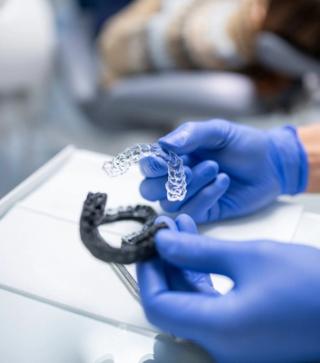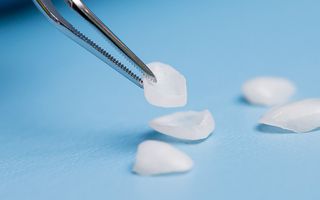Invisalign vs. Veneers: Which is best to get a Straighter Smile?

If you’re eager to transform your smile with straighter teeth this year, National Dental Care Group can help with a range of cosmetic dental options. Invisalign® a clear aligner system, and Veneers are two popular treatments you may have heard of - but which is better for straightening your teeth and improving the appearance of your smile?
Good oral health is crucial for these procedures. Dental issues such as gum disease can affect the decision-making process, so maintaining oral health can ultimately lead to better treatment outcomes.
Read on to discover the benefits of these treatments, as well as what you need to be aware of before making a decision. You can chat with your local National Dental Care Group dentist about which treatment option is best for your situation, what the treatment will involve, and how much it costs.
What Is the difference between veneers and Invisalign®?
While both Invisalign® and veneers can improve your smile, they serve different purposes:
- Invisalign® is an orthodontic treatment that straightens teeth using clear plastic aligners, addressing misalignment, gaps, crowding, and bite issues like overbites or underbites.
- Veneers are a cosmetic treatment made of thin porcelain shells that adhere to the front of the teeth, improving their shape, size, and colour without changing their position.
So, if your primary goal is to correct misalignment, Invisalign® is the best option. If you want to enhance the overall appearance of your teeth by making them whiter and more uniform, veneers may be the way to go.
Invisalign® overview
Invisalign® is a popular orthodontic treatment that uses clear, removable aligners to gradually shift teeth into alignment.

It can address a variety of dental concerns, including:
- Overbites and underbites
- Small gaps between teeth
- Crowded or overlapping teeth
Compared to traditional metal braces, Invisalign offers greater comfort and visibility, making it a more convenient and quicker option for many patients.
Can I get Invisalign® with veneers?
If you already have veneers, Invisalign® may still be an option, but it depends on the condition of your teeth and veneers. Invisalign® aligners work best on natural teeth, so if major realignment is needed, it’s usually recommended before getting veneers.
Consult your dentist to see if Invisalign® is suitable for you. Good oral health is crucial for the success of both treatments, and any underlying dental issues should be addressed before considering Invisalign with veneers.
Benefits of Clear Aligners
Virtually invisible – One of the main advantages of Invisalign® treatment is the fact that the clear aligners are virtually invisible, so you can wear them out and about in your everyday life without the majority of people even knowing you’re undergoing treatment.
Comfortable – Invisalign® aligners are known for being comfortable to wear, especially when compared to more cumbersome metal braces. As the aligners are made from plastic rather than metal, there’s less chance of irritation to your gums and mouth.
Removable – The aligners can easily be removed for activities such as eating and cleaning your teeth. While it’s not advisable to remove your aligners too often, the ability to take them out when needed is very convenient.
Faster than traditional braces – Depending on the condition of your teeth, Invisalign® treatment generally takes less time to correct your smile than traditional metal braces. What’s more, advanced 3D imaging means that you’ll be able to see a simulation of the results of your treatment before you even begin.
Things to consider about Invisalign®
Requires discipline – Aligners must be worn 20-22 hours per day for effective results.
Regular cleaning is essential – You’ll need to brush after every meal to prevent plaque buildup.
Risk of losing aligners – Since they are removable, they can be misplaced if not stored properly.
What to expect from Invisalign treatment?
Invisalign treatment is a modern orthodontic solution that uses clear, removable aligners to straighten teeth.
The journey begins with an initial consultation, where a dental professional evaluates your teeth and determines if Invisalign is the right treatment option for you. Once your treatment plan is set, you’ll receive a series of custom-made aligners designed to be worn for 20-22 hours a day. Maintaining good oral health throughout the Invisalign treatment process is important to ensure the best results.
These aligners are replaced every two weeks, gradually shifting your teeth into alignment. The entire treatment process typically lasts between 6-18 months, depending on the complexity of your case. Invisalign aligners are not only discreet but also allow you to maintain your oral hygiene routine with ease, as they can be removed for eating and brushing.
Veneers overview
Veneers are ultra-thin porcelain veneers bonded to the front of the teeth to improve their appearance by providing a whiter finish, covering up cracks or chips, improving teeth size and alignment, smoothing the surface of the teeth, and closing gaps or spaces between the teeth.

They are a great cosmetic solution for those looking to enhance their smile quickly.
Do you need straight teeth for veneers?
While veneers can create the appearance of a straighter smile, they don’t actually move your teeth. If you have severe misalignment, an overbite, or an underbite, orthodontic treatment like Invisalign® may be required first.
However, for minor adjustments, veneers can give the look of straighter teeth. Good oral health is essential for the success of veneers, and any underlying dental issues should be treated before considering veneers.
Veneers for underbite – are they effective?
Veneers cannot correct an underbite or other bite issues. Since an underbite is caused by jaw misalignment, orthodontic treatment (such as Invisalign® or braces) is necessary to fix the issue. However, once the underbite is corrected, veneers can be used for aesthetic enhancements.
Benefits of veneers
Improves multiple dental concerns – Veneers are used for more than just straightening your smile. They can also help with tooth discolouration, chips or cracks, damaged teeth, and gaps and spaces between teeth.
Long-lasting – Veneers are made of a hard wearing porcelain material. With the correct care and treatment, your veneers can last for up to fifteen years, making them a long-lasting and durable option.
Quick results – It only takes up to two appointments to have your veneers made and fitted - and in many cases, the whole process can be undertaken in a single visit. This means you can transform your teeth and smile in a very short space of time.
Things to consider about veneers
Cosmetic only – They don’t correct functional issues like overbites or underbites.
Permanent alteration – Some enamel is removed before placing veneers.
Colour stays the same – Unlike natural teeth, veneers won’t change colour over time.
Can chip or crack – If not cared for properly, they can become damaged.
What to be aware of with veneers
Veneers are a popular cosmetic treatment option that involves bonding thin sheets of porcelain or composite resin to the front of your teeth. While veneers can dramatically enhance the appearance of your smile, there are some important considerations to keep in mind.
Veneers are not suitable for individuals with underlying dental issues such as gum disease or tooth decay, as these conditions need to be addressed first. Maintaining good oral health is crucial for the success of veneers, and any dental issues should be addressed before getting veneers.
Additionally, veneers can be more costly than Invisalign, especially if multiple teeth are involved. It’s also worth noting that veneers are not a permanent solution; they may need to be replaced over time due to wear and tear. Despite these considerations, veneers offer a quick and effective way to achieve a flawless smile.
Can I get Invisalign® or veneers?
Not everyone is a suitable candidate for Invisalign® or veneers.
Invisalign® is ideal for individuals with mild to moderate orthodontic issues, such as misaligned teeth, gaps, or specific bite irregularities.
Veneers, on the other hand, are best suited for those with cosmetic concerns like stained teeth, chips, or cracks.
To determine your candidacy for either treatment, a professional consultation with a dentist or orthodontist is essential. They will assess your teeth and gums to recommend the best course of action tailored to your needs.
So, which is better - Invisalign® or veneers?
Ultimately, the decision of whether to choose Invisalign® or veneers will depend on your overall goal, the condition of your teeth, and your personal situation. Invisalign® is a great teeth straightening option for people with underlying dental issues such as an overbite or underbite, without large gaps or overly tipped or rotated teeth.
If you’re someone who’s likely to comply with the treatment guidelines - including wearing your aligners for 20-22 hours per day and following the oral hygiene recommendations - Invisalign® can be an ideal way to achieve a straighter smile.
Veneers on the other hand are a fantastic choice for improving the overall appearance of your teeth and addressing specific concerns such as discolouration, gaps, and chips or cracks. They can provide a fast solution for fixing dental issues, leaving you with whiter teeth and a straighter, more even smile.
Get expert advice on the best option for you!
To determine whether Invisalign® or veneers are best for achieving your perfect smile, schedule a consultation with us today. You can book an appointment online to discuss your goals and explore the best cosmetic dental solutions for you.

